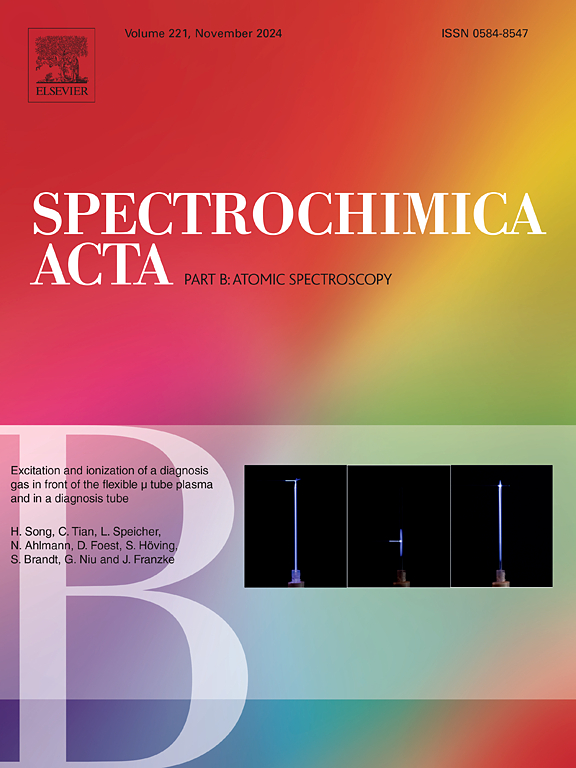Multi-dimensional analysis of NiCr alloy nanofilms based on Ps-LIBS technology
IF 3.2
2区 化学
Q1 SPECTROSCOPY
引用次数: 0
Abstract
With the rapid development of thin film materials, Ni![]() Cr alloy nanofilms have a very wide range of applications in many fields due to their excellent properties. In this paper, Ni
Cr alloy nanofilms have a very wide range of applications in many fields due to their excellent properties. In this paper, Ni![]() Cr alloy nanofilms with different Ni
Cr alloy nanofilms with different Ni![]() Cr content ratios were prepared using electron beam evaporation technology. The calibration curves of the Ni / Cr content ratio and the corresponding spectral line intensity ratio of the thin film samples were plotted. The linear fitting coefficient (RZhou and Tian (2005) [2]) of this calibration curve reached 0.99, which had a good linear fitting degree. The quantitative analysis of Ni
Cr content ratios were prepared using electron beam evaporation technology. The calibration curves of the Ni / Cr content ratio and the corresponding spectral line intensity ratio of the thin film samples were plotted. The linear fitting coefficient (RZhou and Tian (2005) [2]) of this calibration curve reached 0.99, which had a good linear fitting degree. The quantitative analysis of Ni![]() Cr alloy thin film samples was carried out by Picosecond Laser Induced Breakdown Spectroscopy (Ps-LIBS). Calculated using the Boltzmann method and the Stark broadening method, the plasma electron temperature (T) was about 7048 K and the electron density (Ne) was about 6.08 × 1016 cm−3, and then the plasma characteristics of Ps-LIBS technology were preliminarily studied. In order to further realize the analysis of thin film samples, the depth profile of thin film samples was preliminary analyzed using the Ps-LIIBS technology and the thickness of a single laser pulse ablation was about 75 nm, which could be used to evaluate the thickness of the thin films. All the results show that Ps-LIBS technology can be used to realize the quantitative and quantitative analyses of Ni
Cr alloy thin film samples was carried out by Picosecond Laser Induced Breakdown Spectroscopy (Ps-LIBS). Calculated using the Boltzmann method and the Stark broadening method, the plasma electron temperature (T) was about 7048 K and the electron density (Ne) was about 6.08 × 1016 cm−3, and then the plasma characteristics of Ps-LIBS technology were preliminarily studied. In order to further realize the analysis of thin film samples, the depth profile of thin film samples was preliminary analyzed using the Ps-LIIBS technology and the thickness of a single laser pulse ablation was about 75 nm, which could be used to evaluate the thickness of the thin films. All the results show that Ps-LIBS technology can be used to realize the quantitative and quantitative analyses of Ni![]() Cr alloy nanofilms prepared using the electron beam evaporation technology, which provides technical support for exploring the application potential of Ni
Cr alloy nanofilms prepared using the electron beam evaporation technology, which provides technical support for exploring the application potential of Ni![]() Cr alloy nanofilms in practice.
Cr alloy nanofilms in practice.

基于 Ps-LIBS 技术的镍铬合金纳米薄膜多维分析
随着薄膜材料的快速发展,镍铬合金纳米薄膜因其优异的性能在许多领域都有非常广泛的应用。本文利用电子束蒸发技术制备了不同镍铬含量比的镍铬合金纳米薄膜。绘制了镍/铬含量比和薄膜样品相应光谱线强度比的校准曲线。该校正曲线的线性拟合系数(RZhou 和 Tian (2005) [2])达到 0.99,具有良好的线性拟合度。采用皮秒激光诱导击穿光谱法(Ps-LIBS)对镍铬合金薄膜样品进行定量分析。通过波尔兹曼法和斯塔克展宽法计算,等离子体电子温度(T)约为 7048 K,电子密度(Ne)约为 6.08 × 1016 cm-3,初步研究了 Ps-LIBS 技术的等离子体特性。为了进一步实现对薄膜样品的分析,利用 Ps-LIIBS 技术初步分析了薄膜样品的深度剖面,单个激光脉冲烧蚀的厚度约为 75 nm,可用于评估薄膜的厚度。所有结果表明,Ps-LIBS 技术可用于实现对电子束蒸发技术制备的镍铬合金纳米薄膜的定量定性分析,为探索镍铬合金纳米薄膜在实践中的应用潜力提供了技术支持。
本文章由计算机程序翻译,如有差异,请以英文原文为准。
求助全文
约1分钟内获得全文
求助全文
来源期刊
CiteScore
6.10
自引率
12.10%
发文量
173
审稿时长
81 days
期刊介绍:
Spectrochimica Acta Part B: Atomic Spectroscopy, is intended for the rapid publication of both original work and reviews in the following fields:
Atomic Emission (AES), Atomic Absorption (AAS) and Atomic Fluorescence (AFS) spectroscopy;
Mass Spectrometry (MS) for inorganic analysis covering Spark Source (SS-MS), Inductively Coupled Plasma (ICP-MS), Glow Discharge (GD-MS), and Secondary Ion Mass Spectrometry (SIMS).
Laser induced atomic spectroscopy for inorganic analysis, including non-linear optical laser spectroscopy, covering Laser Enhanced Ionization (LEI), Laser Induced Fluorescence (LIF), Resonance Ionization Spectroscopy (RIS) and Resonance Ionization Mass Spectrometry (RIMS); Laser Induced Breakdown Spectroscopy (LIBS); Cavity Ringdown Spectroscopy (CRDS), Laser Ablation Inductively Coupled Plasma Atomic Emission Spectroscopy (LA-ICP-AES) and Laser Ablation Inductively Coupled Plasma Mass Spectrometry (LA-ICP-MS).
X-ray spectrometry, X-ray Optics and Microanalysis, including X-ray fluorescence spectrometry (XRF) and related techniques, in particular Total-reflection X-ray Fluorescence Spectrometry (TXRF), and Synchrotron Radiation-excited Total reflection XRF (SR-TXRF).
Manuscripts dealing with (i) fundamentals, (ii) methodology development, (iii)instrumentation, and (iv) applications, can be submitted for publication.

 求助内容:
求助内容: 应助结果提醒方式:
应助结果提醒方式:


